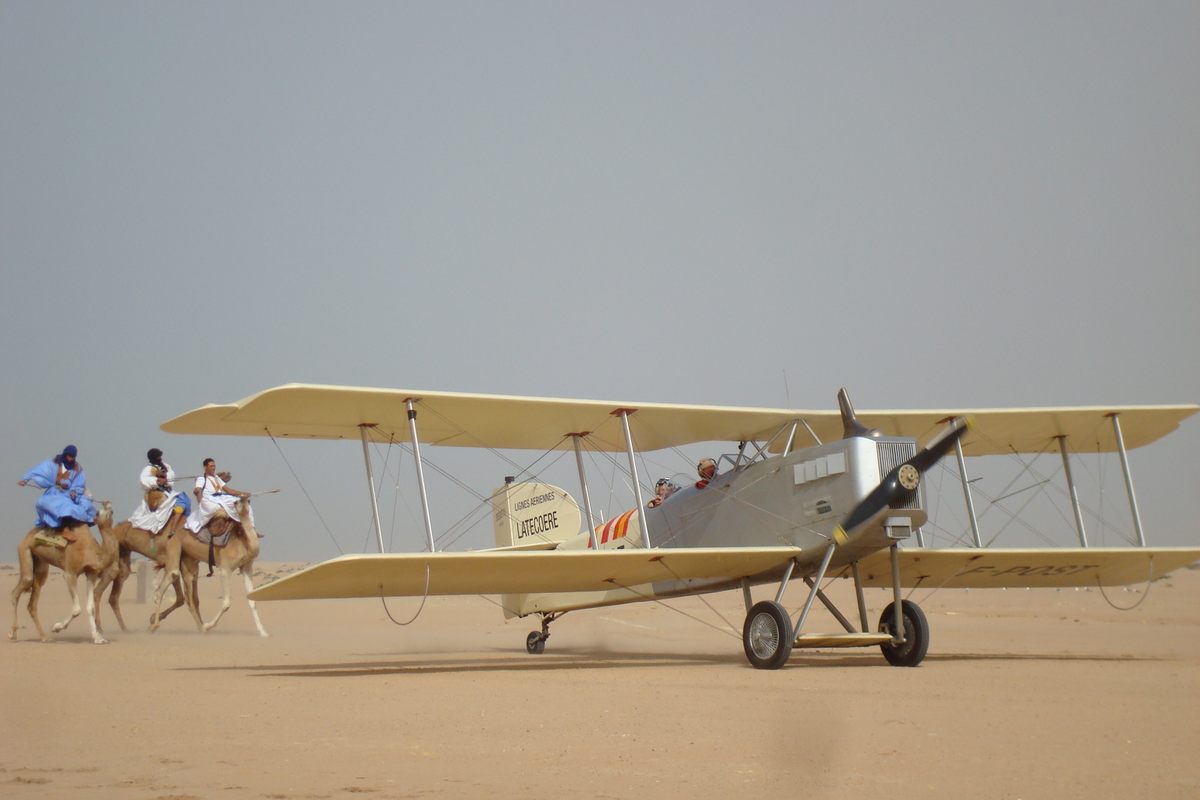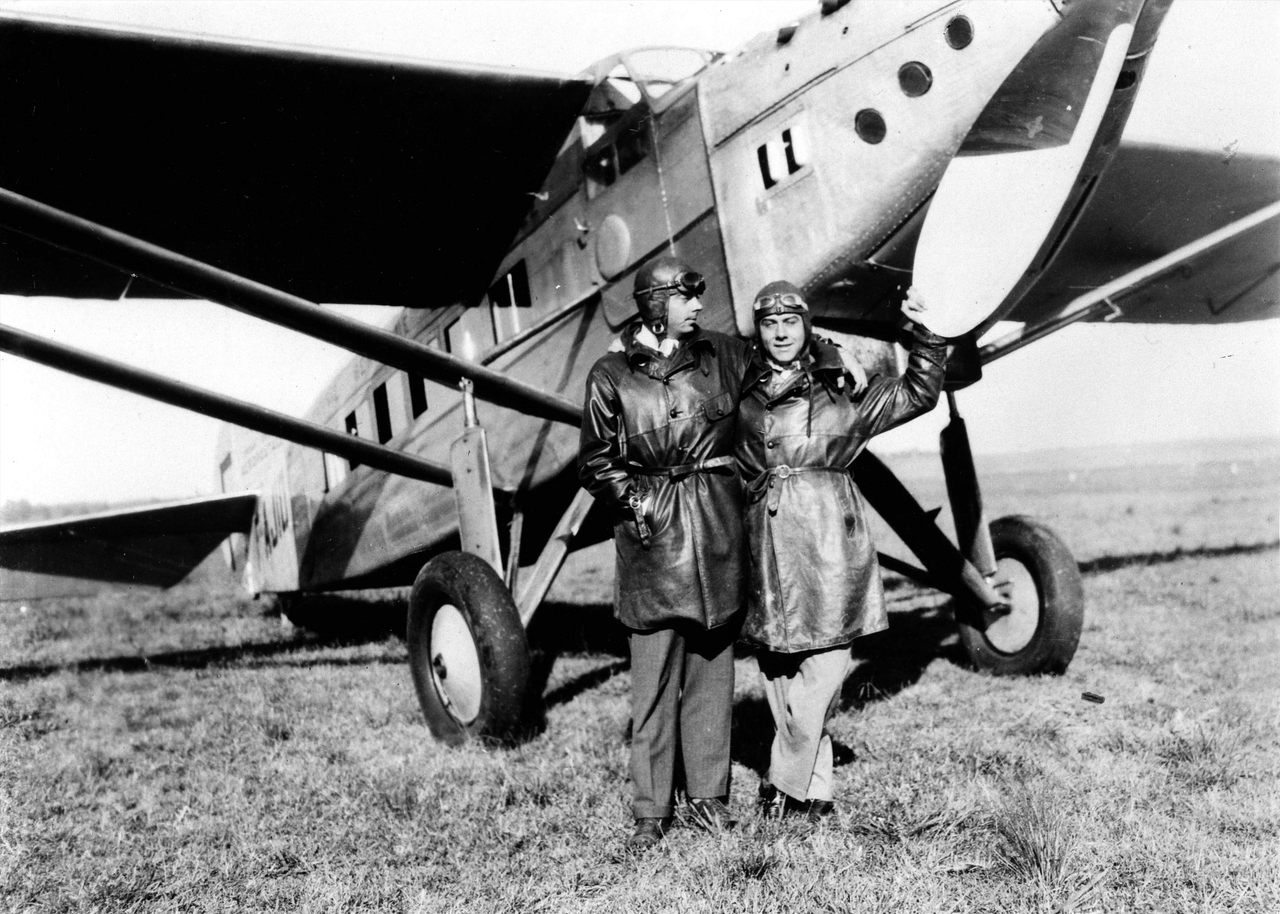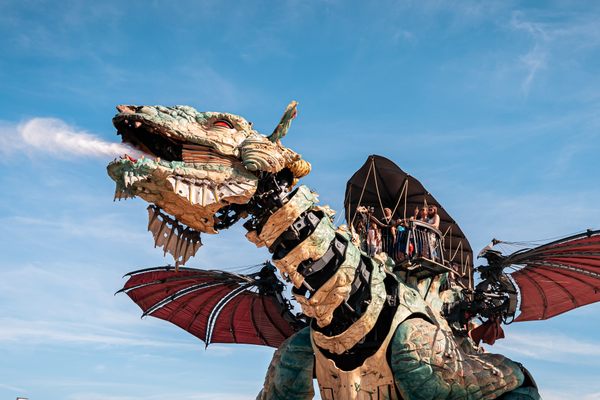The Daring Desert Pilots That Inspired ‘The Little Prince’
And the modern pilots retracing their pioneering airmail flights.
From the air, Tarfaya first appears little more than a discoloration—a grey smear of concrete in a vast expanse of yellow sand. As pilot Maxime Raynaud banks over the desolate coastline of Morocco’s far south, he can just make out a fishing port, a faded white fortress, and a ruined castle marooned in the sea.
The landing can be tricky, and Raynaud approaches fast to steady his Tecnam P2010 aircraft in the strong crosswinds, avoiding two radio antennae before touching down on a dirt airstrip peppered with small stones. At 2000 feet, the airstrip leaves little margin for error.
“We don’t carry much fuel, and we can’t refuel here,” says Raynaud. “If we made a second approach, we might have to divert.”

For the fifteen crews of the Toulouse-Tarfaya air rally, of which Raynaud heads one, diverting is barely an option—they have flown for four days and 1,400 miles to be here. It is a pilgrimage that has been repeated annually for 40 years, first as part of the longer Toulouse-Saint Louis rally, and now also in this separate rally that culminates in Tarfaya. The remote Saharan outpost is an aviation and literary legend.
Formerly the Spanish military base of Cape Juby, Tarfaya was once a crucial stop on the first intercontinental airmail service, Lignes Latécoère, later named Aéropostale. Based in France’s aviation capital Toulouse, Aéropostale was operated by a network of daredevil pilots flying rickety biplanes down the West African coast. Among them was Antoine de Saint-Exupéry, author of The Little Prince. From 1927 to 1929, Saint-Exupéry managed Tarfaya’s airfield, where he wrote his first novel, Southern Mail, and became entranced with the immensity of the desert.
“Being at the end of the world here was really important for him to meditate and build his philosophy,” says Olivier d’Agay, Saint-Exupéry’s great-nephew, as he stands at Tarfaya’s airstrip. “Aéropostale and The Little Prince were born here.”

In 1983, Moroccan-born journalist and aviation enthusiast André Sabas organized the first air rally to honor this history, retracing the Aéropostale route from Toulouse through Spain, Morocco, and Mauritania to Saint Louis, Senegal. At the time, Jean-Jacques Galy was a young doctor and passionate amateur pilot, himself the son of an aviator. He had grown up on stories of Aéropostale and leaped at the chance to emulate his heroes. From the first rally, he was hooked. He participated again in 1984, returned in 1991 as an organizer, and has directed the rally since 2010. His admiration for the Aéropostale pioneers remains undimmed.
“It’s important in life to have a mission,” he says. “They had that. To the point, they risked their lives. They did it because they were 25, they feared nothing. If one person did well, the other wanted to do better.”
This determination also characterized Aéropostale’s founder, Pierre Georges Latécoère, a manufacturer of World War I aircraft. After the war, Latécoère hatched an audacious vision for idle planes and pilots: to carry mail unprecedented distances through West Africa, then across the Atlantic to South America. “I have redone all the calculations; they confirm the specialists’ opinion: our idea is unfeasible,” Latécoère famously uttered. “There is only one thing to do: make it happen!”
After a year of test flights, Latécoère secured a Moroccan government grant and inaugurated the Toulouse-Rabat line in September 1919. In 1923, he sent three pilots to explore a route to Senegal. Exactly a century before this year’s rally landed in Tarfaya, they departed Tarfaya on the return from their successful mission. By 1925, mail was running daily from Toulouse to Senegal and crossing to Brazil by boat. Although financial problems forced Latécoère to sell the line in 1927, his pilots kept the dream alive, reaching Chile by air in May 1930.

“In 1920, sending a letter from France to Chile took two and a half months. After Aéropostale, the letter traveled in one week,” says Sadat Shaibata Mrabih Rabou, director of Tarfaya’s Aéropostale museum. “It was the first step of the acceleration of communications.”
The human cost was high: 120 pilots died, victims of bad weather or engine failure. Others were kidnapped by anticolonial Saharan nomads, who shot at passing planes and took hostage those forced to land in the desert. In 1928, two Aéropostale pilots spent 117 days captive south of Tarfaya, while Saint-Exupéry, at the time only 28, negotiated their ransom. “The Moors are asking for a million rifles, a million pesetas [around $40 million today], a million camels,” he noted, adding sarcastically: “Nothing!”
But the biggest threat was Aéropostale’s own schedule. Pilots flew in all conditions, risking death to meet their daily deliveries. “You can’t forget that everything was a test, everything was new in aviation,” says Aéropostale historian Jean-Claude Nivet. “The mail had to arrive on time. In bad weather, you had to go. If not, governments and post offices wouldn’t contract you.”
The modern rally takes no such risks, and engines, communications, and weather forecasting are all hugely improved. All participants must have over 250 hours of flying time and must apply to take part in the rally. But not all dangers can be eliminated.

“Mist is the great enemy,” says Thierry Sentous, a rally participant since 1994 and now communications director. “You can’t land, because you can’t see the ground,” he says. “Then there’s the wind, the sandstorms. There are times we’ve hit clouds of locusts. They cover the windscreen and you can’t see, or worse, they block the engine’s air vents.”
In 2018, Sentous’s engine started to malfunction over the dunes about 150 miles from Nouadhibou, Mauritania. Losing power, Sentous and his copilot found a highway and followed it, preparing to land on the road if the engine failed. They finally limped into Nouadhibou’s airfield, where dedicated mechanics spent three days helping repair the plane.
Even the desert’s human threat has echoed down through the decades. In the 1980s, Sahrawi militants, fighting for independence from Morocco, shot at a rally plane.
In general, however, the rally takes pride in connecting with local communities, as Saint-Exupéry did a century before. The writer’s intercultural learnings in Tarfaya later inspired The Little Prince—a fable of a desert encounter between a crashed pilot and an enigmatic alien child, who recounts what his journeys through space have taught him about human nature and love. Today, it is the most translated book after the Bible, and the rally celebrates its legacy through donations and activities with Tarfaya’s schools.
“The Little Prince is an icon, an ambassador of peace,” says d’Agay. “It’s important to share this memory with the people of Tarfaya. They know this is their story, too.”
Years before becoming a museum director, Shaibata, who grew up in Tarfaya, remembers running to greet landing planes, as local children still do today. He sees the rally as a bridge between his hometown and the outside world, which he hopes to deepen through a knowledge exchange network or the sharing of financial resources among the towns on the Aéropostale route. “The objective is not only keeping this memory alive, but using it to help development,” he says.

In the evening, rally participants gather alongside Tarfaya’s residents to watch a light show on the museum’s façade, before retiring to a starlit desert camp. In this year of anniversaries—100 years from the opening of the Senegal route; 80 years from the publication of The Little Prince; and 40 years from the first rally— there is celebration but also reflection, as organizers ponder how the dream of flying can be preserved for a generation facing new issues such as climate change. Likewise, reverence for the Aéropostale pioneers who shrank the world sits alongside nostalgia for an era when the earth felt vast, mysterious, and unexplored.
Saint-Exupéry also grappled with this tension, as his colleagues pushed their planes ever longer distances, eventually negating the need for remote fuel stops like Tarfaya. “The horizons of our journeys have faded out one after another,” he lamented in his memoir, Wind, Sand and Stars. He found solace in the intense camaraderie he experienced along the way, reflecting “perhaps the greatness of a calling lies in the unity it creates.”
This solidarity facing an epic challenge is what modern rally participants seek to recreate. “Our actions allow us not to forget” Aéropostale’s legacy, Galy says. “We don’t just talk about this history; we live this history.”


























Follow us on Twitter to get the latest on the world's hidden wonders.
Like us on Facebook to get the latest on the world's hidden wonders.
Follow us on Twitter Like us on Facebook